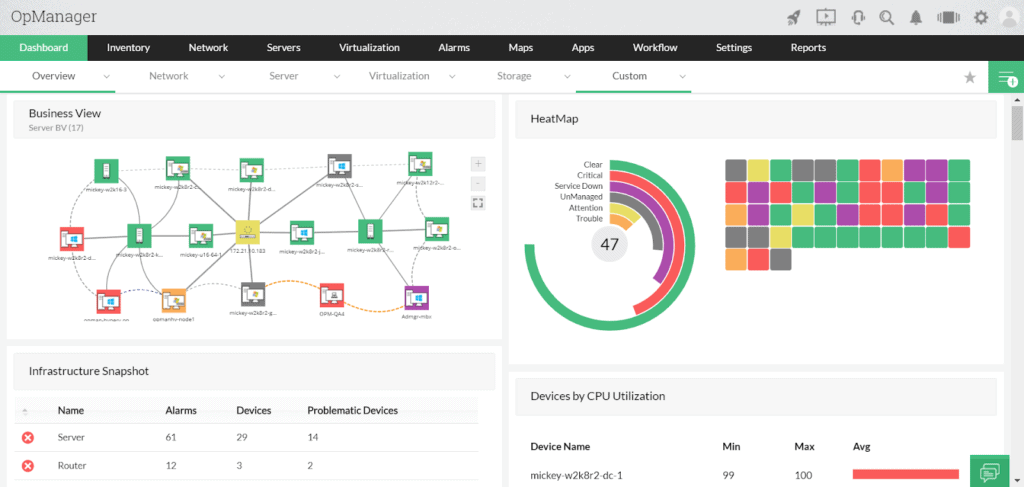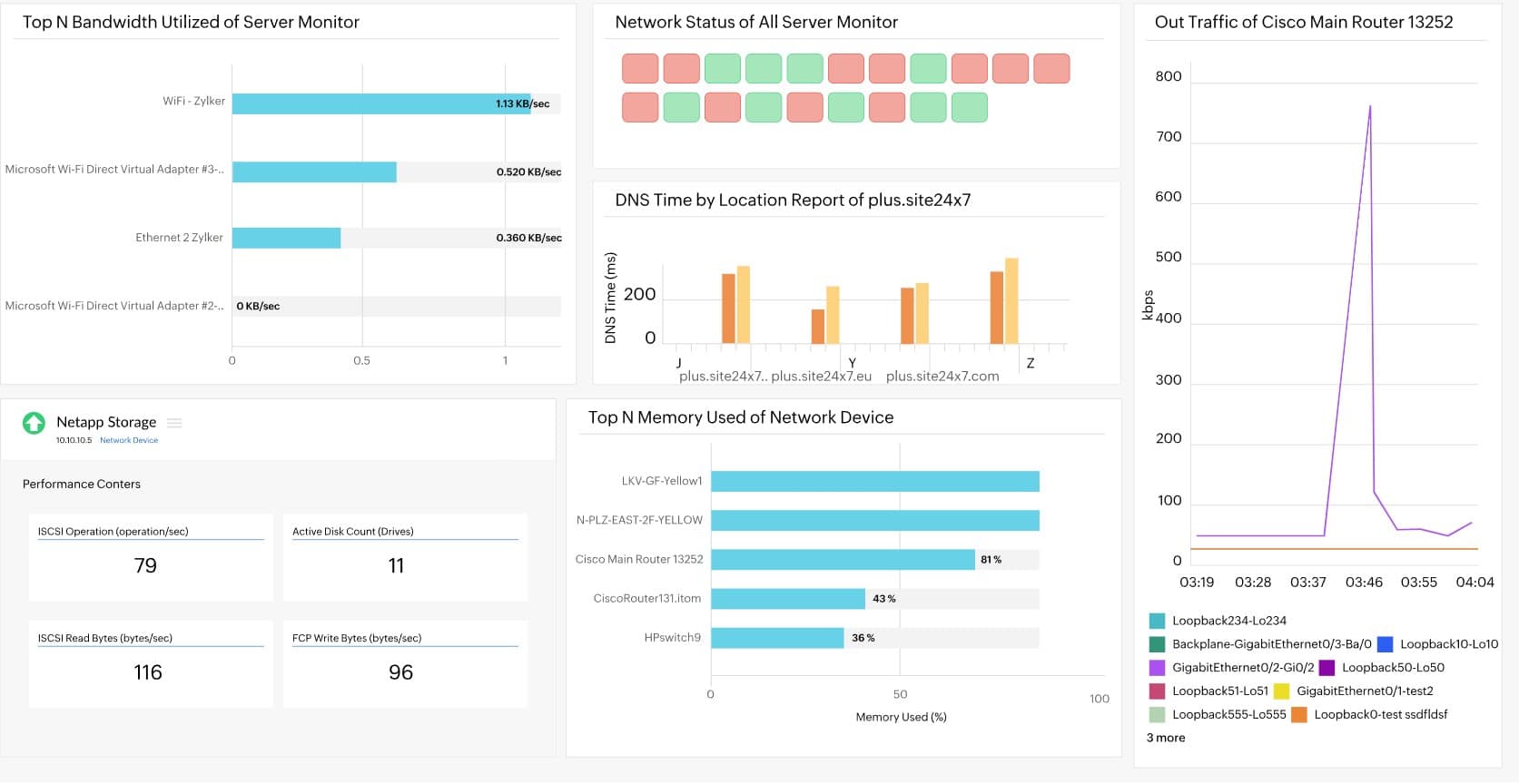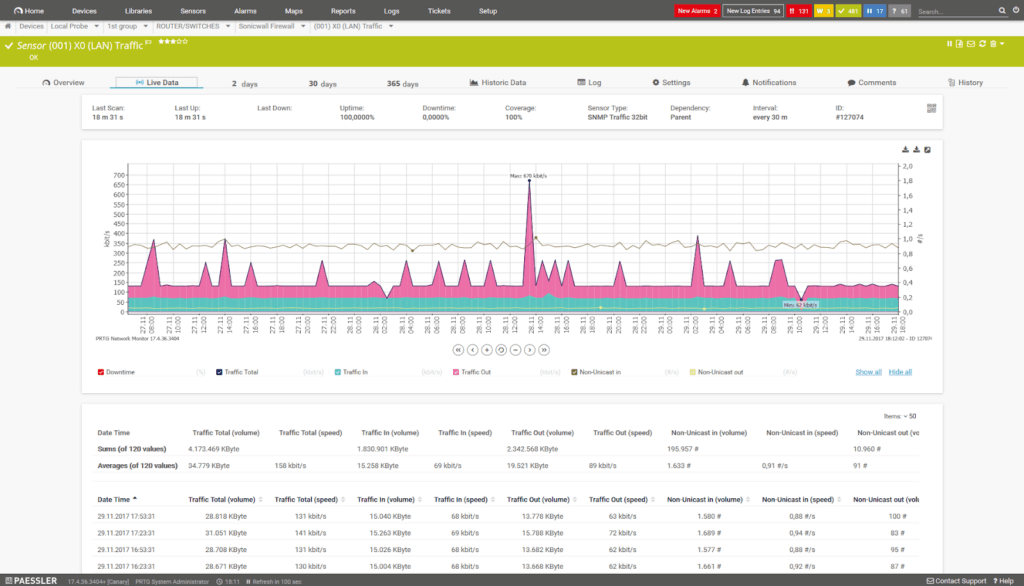We may earn a commission if you make a purchase through the links on our website.
The Best Data Center Management Software & Tools for NOC Operations
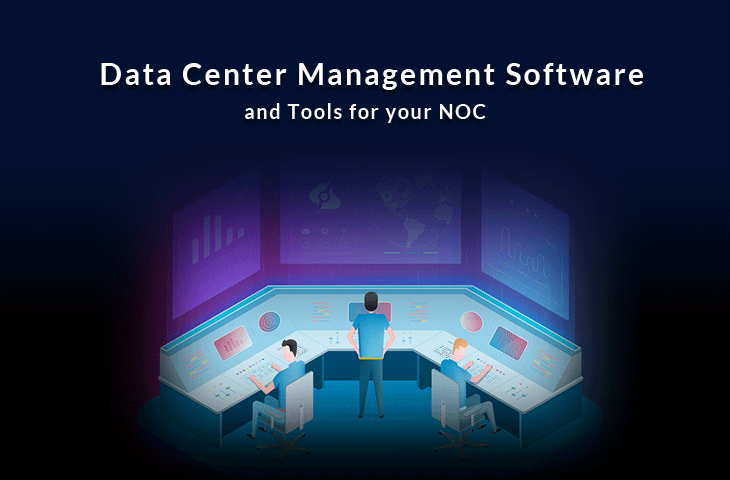
UPDATED: January 7, 2025
Data centers are complex and delicate environments. They are made of thousands of different components performing different operations, from servers, network devices, storage, virtual machines, to cooling and power units.
All components are interconnected through underground or top-of-the-rack cabling and connected to power distribution units. IT managers & NOC engineers struggle to keep control of every single detail in their data center infrastructure.
Most of the time, they are running their data centers with tools such as Excel and Visio. But running a sophisticated facility with a spreadsheet is a recipe for disaster.
Here is our list of the best data center management software for NOC operators:
- ManageEngine OpManager – EDITOR'S CHOICE Provides monitoring tools for physical and virtual services on a network. Watch over your network devices and monitor your hypervisors with this package. Available for Windows Server and Linux. Download a 30-day free trial.
- Site24x7 – FREE TRIAL This cloud-based platform offers a data center management solution with real-time monitoring, performance insights, resource management, and automated alerts. Get a 30-day free trial.
- Paessler PRTG Network Monitor – FREE TRIAL This bundle includes a large number of monitoring tools for networks, servers, and applications. You tailor the package by deciding which sensors to turn on. Runs on Windows Server. Start a 30-day free trial.
- NLyte Software Watches over all of your data center infrastructure that includes hardware and services performance tracking. This is a SaaS platform.
- Kaseya VSA Remote monitoring and management package (RMM) aimed at managed service providers that includes all of the technician tools needed to watch over and run the systems of clients. This is a SaaS platform.
- SolarWinds Network Performance Monitor A platform of services that offer network and device monitoring with specialist modules for different equipment and services on your network. Buy all of the units or just select one or two to provide all your network monitoring needs. Runs on Windows Server.
- Device42 This system monitoring platform is centered around a discovery and mapping module that creates an asset inventory. Get live monitoring of all discovered devices with this virtual appliance that installs on cloud platforms, Citrix, VMWare, or Hyper-V.
- Zabbix This free system monitoring package covers networks, servers, and applications. It searches the network for all devices and creates a network topology map and then starts live monitoring. Runs on Linux.
- Nagios A monitoring package for networks servers, and applications that can be extended by thousands of free plugins. Available in free and paid versions, this package installs on Linux or on Windows over a hypervisor.
NOC Engineers need software capable of planning for capacity, inventorying, maximizing uptime, unifying visibility, automation, reporting, and more.
What is Data Center Management Software?
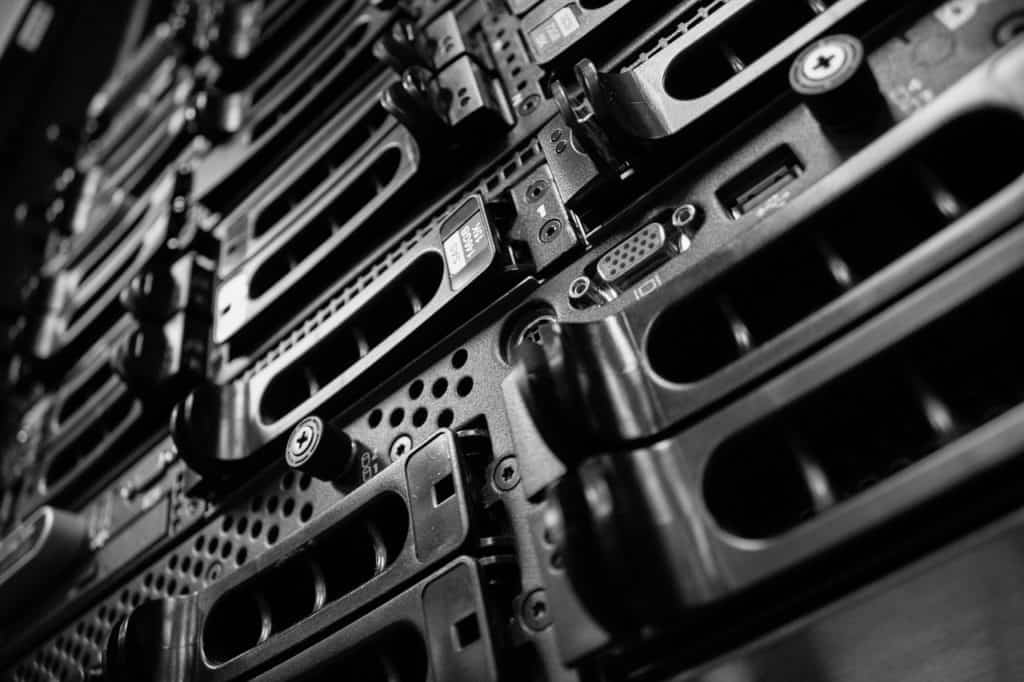
Data Center Management software allows admins to run their IT infrastructure efficiently, improve its uptime, and reduce costs.
This software is built to provide daily insights into the operations and health of the data center. Advanced management software can perform data center tasks automatically.
The software also provides a centralized platform for easy access and management of the infrastructure and services. It can help different IT departments within an organization such as DevOps, Infrastructure, Networking, etc. to collaborate and work from a single platform.
The most common type of data center management software is known as the DCIM (Data Center Infrastructure Management), which focuses only on the infrastructure. Other tools can be broader and provide information on other elements such as network, storage, virtual, applications. These same tools can also give you access to alerting, reporting, automation, and more capabilities.
Data Center Management Software Services:
On a basic level, data center management software should be capable of providing the following:
- Node details: Display device information such as status, vendor, IP, type, system name, etc.
- Unified visibility: Get a centralized view across all the elements in the data center.
- Layouts and maps: Get a graphical 2D or 3D representation of the data center room, its cabinet layout, and the cabling.
- Configuration and change: Document and monitor configuration and changes.
- Environment: Manage and monitor the power, and environmental factors of your data center.
- Automate processes: Automate common processes like scheduling, backups, compliance checks, node discovery, etc.
Other comprehensive data center management software can provide additional information that popular DCIM products cannot, such as:
- Network management: Monitor and manage different multi-vendor data center network technologies.
- Compute infrastructure: Manage your entire on-premises physical and virtual computing infrastructure.
- Manage storage: Keep track and control all your data center storage devices, such as DAS, NAS, or SAN.
- Manage applications: Keep control of your applications deployed in your data center.
- Reporting and alerting capabilities: Generate reports to gain insights into your data center and get alarms when there is a failure.
Best Data Center Management Software
Our methodology for selecting a data center management tool
We reviewed the market for data center management software and analyzed options based on the following criteria:
- Network, server, and application monitoring software
- Monitoring automation with alerts for system performance problems
- Easy-to-read dashboard with data interpreted into color-coded graphs and dials
- Integration between tools that can provide seamless data sharing
- Option to centralize the monitoring of multiple sites in one location
- Free trial or demo package that allows the system to be evaluated before buying
- Value for money from a comprehensive automated monitoring tool that will save the cost of staff
With these selection criteria in mind, we identified a number of data center management tools, including both on-premises and SaaS options.
1. ManageEngine OpManager – FREE TRIAL
ManageEngine OpManager is a popular network monitoring and management solution. It can help you keep track of all devices within a data center, from routers, switches, firewalls, wireless APs, VMs, etc. OpManager monitors your data center’s network and provides a complete overview and control.
Key Features:
- Proactively Monitor Physical & Virtual Servers: Gain real-time insights into server performance to preemptively address potential issues.
- Keep Track of Applications and Bandwidth with Applications Manager: Monitor application performance and bandwidth consumption to optimize resource allocation.
- Monitor Flow-Based Traffic: Track network traffic patterns to identify potential bottlenecks and optimize network performance.
- Check Data Center Environment: Monitor environmental factors such as temperature and humidity to maintain optimal conditions for equipment.
- 3D Data Center Flooring Views: Visualize data center layout in three dimensions for enhanced spatial awareness and management.
Why do we recommend it?
ManageEngine OpManager is a highly regarded network monitoring and management solution renowned for its reliability and extensive feature set. Our own experiences with OpManager have highlighted its effectiveness in providing comprehensive oversight of data center infrastructure. With OpManager, you can proactively monitor network devices and swiftly address issues before they impact end users, ensuring uninterrupted operations. Its intuitive interface and robust root cause analysis capabilities empower IT professionals to resolve faults efficiently, minimizing downtime and enhancing productivity. OpManager's Enterprise Edition offers a holistic data center management solution, equipped with advanced features to meet the evolving needs of modern businesses.
When there is a fault, OpManager can provide root cause analysis, so that you can solve the issue before they impact the end user. The OpManager Enterprise Edition offers a comprehensive data center management. The unified web console helps you gain visibility over the entire data center, scale up as needed, and send automatic health reports.
Who is it recommended for?
ManageEngine OpManager is recommended for IT professionals and system administrators responsible for managing data center infrastructure. Whether you oversee a small network or a large-scale enterprise environment, OpManager caters to diverse needs with its scalable architecture. Specifically, OpManager is ideal for organizations seeking a comprehensive solution for monitoring physical and virtual servers, applications, and network traffic within their data centers. Its user-friendly interface and customizable alerting system make it suitable for businesses of all sizes, offering flexibility and ease of use. From small enterprises to large corporations, OpManager provides the tools necessary to ensure optimal performance and reliability across data center environments.
Pros:
- Customizable Dashboards: Features over 200 customizable widgets to build unique dashboards and reports tailored to your organization's needs.
- Auto Discovery: Utilizes auto discovery to efficiently find, inventory, and map new devices, streamlining network management processes.
- Intelligent Alerting: Uses intelligent alerting to reduce false positives and eliminate alert fatigue, ensuring timely notification of critical issues.
- Multiple Alerting Channels: Supports email, SMS, and webhook for flexible alerting across various communication channels.
- Seamless Integration: Integrates well within the ManageEngine ecosystem, facilitating seamless collaboration with other ManageEngine products.
Cons:
- Steep Learning Curve: As a feature-rich tool, OpManager may require a time investment to fully grasp its functionalities and maximize its potential.
OpManager is available in four editions, Free, Essential, Enterprise, and Service Packs. For more information request a quote. Start by downloading a 30-day free trial.
2. Site24x7 – FREE TRIAL
Site24x7 is a cloud platform of system monitoring and management services that provides a Data Center Infrastructure Management (DCIM) solution. This unit is designed to optimize and streamline the management of data centers. The utility includes real-time monitoring, which offers a comprehensive view of all aspects of the data center’s performance, from hardware health to environmental conditions.
Key Features:
- Network Monitoring: Continuous monitoring of network devices like routers, switches, firewalls, and load balancers to ensure uptime and performance.
- Server Monitoring: Tracks CPU, memory, disk utilization, and other crucial server performance metrics for various server types (e.g., application servers, web servers, database servers).
- Virtualization Monitoring: Monitors virtual infrastructure across platforms like VMware, Nutanix, and Hyper-V.
- Cloud Monitoring: Keeps an eye on cloud services such as AWS, Azure, and GCP, along with the applications hosted in them.
Why do we recommend it?
Site24x7 allows organizations to track critical metrics like power usage, temperature, humidity, and system uptime, ensuring the infrastructure operates efficiently and without interruption. The package provides monitoring for both on-premise and cloud-based infrastructure, providing a unified view of an organization's entire IT environment. This is a cloud-based system that can remotely monitor multiple sites.
Data center managers can gain deep insights into resource utilization with Site24x7, enabling proactive decision-making and preventing potential failures. The solution supports a variety of monitoring features, including real-time alerts, detailed dashboards, and analytics tools. These features help identify potential bottlenecks and ensure optimal performance.
Who is it recommended for?
Clearly, the DCIM features of Site24x7 are designed for companies that run data centers. A typical data center is a large organization; so, in this case, Site24x7 caters to large businesses. However, the Site24x7 platform isn’t just designed for data centers and the company provides accounts for small businesses as well for system monitoring.
Pros:
- Physical Infrastructure Monitoring: Tracks power distribution units, cooling systems, and other hardware components.
- Capacity Planning: Helps in capacity planning and resource optimization to cut infrastructure costs.
- Security Monitoring: Ensures network and physical security, including firewall and load balancer performance.
- Environmental Monitoring: Monitors physical environmental conditions and energy efficiency.
Cons:
- Headline prices are for small businesses: Large companies will pay a lot more than the advertised price.
Site24x7 offers many plans but all of them include all of the modules on the platform but with varying capacities per unit. All plans are priced to be suitable for small businesses and larger companies pay supplements for more capacity. You can get a 30-day free trial of the entire platform.
3. Paessler PRTG Network Monitor – FREE TRIAL
PRTG Network Monitor is another comprehensive network monitoring and management solution. It is one of the most popular and well-known products on the market.
Key Features:
- Monitor Applications and Services Hosted in Your Data Center: Gain insight into the performance of critical applications and services to ensure uninterrupted operations.
- Keep Track of Your Data Center Environment: Monitor environmental factors such as temperature and humidity to maintain optimal conditions for equipment.
- Unified Monitoring Solution for Thousands of Different Vendors: PRTG supports a wide range of devices and vendors, providing comprehensive visibility into your entire network infrastructure.
- Receive Automatic Alerts and Notifications: Stay informed about network issues with customizable alerts delivered via SMS, email, or third-party integration.
- Generate In-Depth Data Center Reports: Generate detailed reports to analyze network performance trends and identify areas for optimization.
Why do we recommend it?
Paessler PRTG Network Monitor offers a robust suite of features tailored to meet the demands of modern network monitoring and management. With a focus on user-friendly design and comprehensive functionality, PRTG Network Monitor stands out as a top choice for businesses seeking reliable performance monitoring. Our own testing and experience with PRTG have demonstrated its effectiveness in providing real-time insights into network health and performance. Additionally, PRTG's intuitive interface and customizable alerting system ensure that IT professionals can swiftly identify and address issues before they escalate. Whether you're a small business or an enterprise, PRTG Network Monitor offers scalability and flexibility to adapt to your evolving needs.
Who is it recommended for?
Paessler PRTG Network Monitor is recommended for IT professionals and system administrators tasked with managing network infrastructures of varying sizes. Its flexible architecture caters to the needs of businesses ranging from small enterprises to large corporations. Specifically, PRTG Network Monitor suits organizations seeking a comprehensive solution for monitoring and managing their data centers. Whether you're monitoring applications, services, or environmental factors within your data center, PRTG provides the tools necessary to ensure optimal performance and reliability. Moreover, PRTG's unified monitoring solution supports thousands of different vendors, making it an ideal choice for businesses with diverse IT environments.
PRTG Network Monitor can keep an eye on every component of your data center, from servers, the network, systems, traffic, applications, VMs, hardware, etc. PRTG is based on monitoring sensors. Each sensor keeps track of a component within a device, such as CPU, latency, memory, etc. Sensors can also monitor overall aspects in the network, like traffic, bandwidth, environment, etc.
Pros:
- Packet Sniffing, WMI, and SNMP: Utilizes various monitoring methods to report network performance and discover new devices.
- Auto Discovery: Reflects inventory changes almost instantaneously, ensuring up-to-date network monitoring.
- Drag-and-Drop Editor: Easily build custom views and reports with a user-friendly interface.
- Wide Range of Alert Mediums: Supports SMS, email, and third-party integration for comprehensive alerting.
- Freeware Version: Offers a freeware version for users with basic monitoring needs.
Cons:
- Comprehensive Platform: With numerous features and components, PRTG Network Monitor may require time to fully explore and utilize effectively.
- Challenging Custom Sensors Configuration: Manually configuring custom sensors can be complex and time-consuming.
The price for PRTG500 starts at $1,600. PRTG500 allows you up to 500 monitoring sensors and one server installation. Free PRTG100 is available for up to 100 sensors. You can also download a 30-day free trial with unlimited sensors.
4. NLyte Software
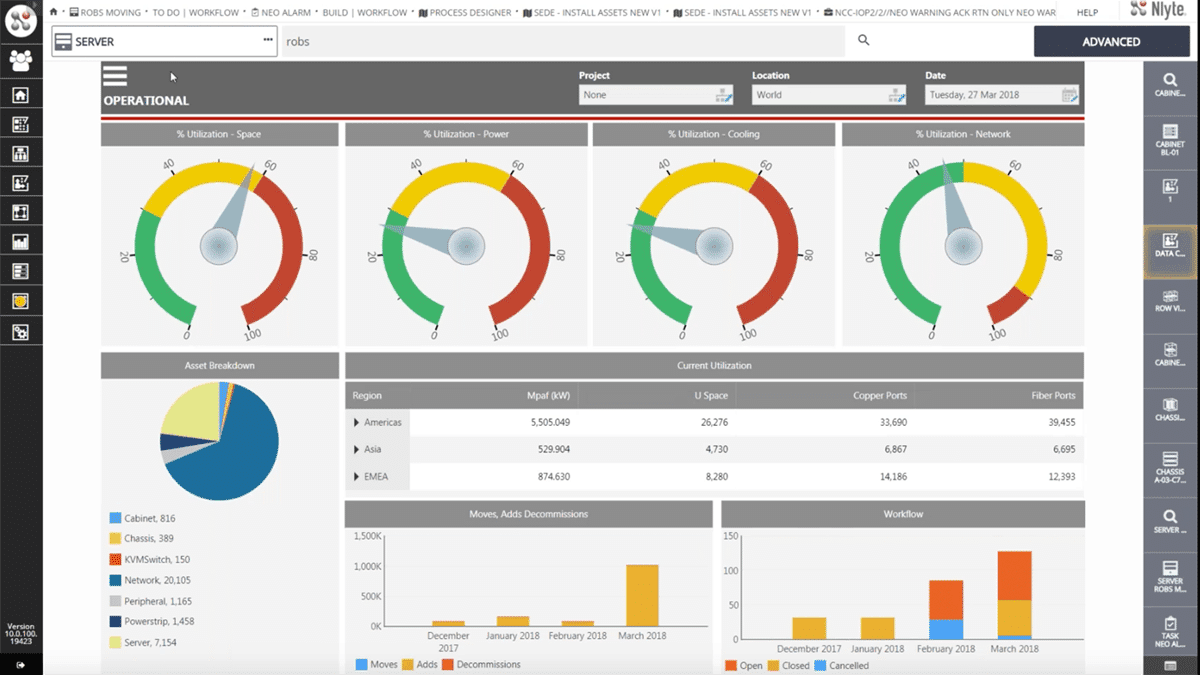
Nlyte Software is a popular DCIM tool that focuses on the management, planning, and optimization of your data center. The software can help maintain physical, virtual, or edge environments within a data center and optimize their utilization.
Key Features:
- Computing Infrastructure Management: Gain centralized control over computing infrastructure assets, ensuring efficient management and optimization.
- Asset Lifecycle Management: Maintain a detailed inventory of data center assets and streamline asset lifecycle processes for enhanced efficiency.
- Comprehensive Dashboards and Reports: Access insightful dashboards and reports to gain actionable insights into data center operations and performance.
- Capacity Planning: Utilize advanced capacity planning tools to forecast future resource requirements and optimize data center utilization
- Real-Time Data Collection: Collect and analyze data in real-time to monitor data center performance and swiftly identify and address issues.
Why do we recommend it?
Nlyte Software emerges as a leading DCIM renowned for its robust management, planning, and optimization capabilities. With a focus on maintaining physical, virtual, and edge environments, Nlyte Software offers a comprehensive solution for businesses seeking to optimize their data center infrastructure. Its intuitive interface and powerful automation capabilities empower users to efficiently manage assets, workflows, and reporting processes. Nlyte Software's commitment to innovation and continuous improvement makes it a top choice for organizations striving for excellence in data center management.
Nlyte software keeps a detailed inventory of your data center assets and monitors the environment. The auto-discovery process maintains an updated list of all equipment, and it also tracks changes in the configuration. The software comes with powerful automation capabilities. It can automate processes such as the discovery of nodes, asset management, workflows, and reporting.
Who is it recommended for?
Nlyte Software is recommended for enterprises and data centers of all sizes seeking a sophisticated DCIM solution. Whether you're managing a small-scale data center or a large enterprise infrastructure, Nlyte Software caters to diverse needs with its scalable and versatile platform. Specifically, Nlyte Software is ideal for organizations requiring comprehensive asset lifecycle management, capacity planning, and real-time monitoring capabilities. Its sleek user interface and intuitive features make it suitable for both technical and non-technical users, offering ease of use and flexibility. From small businesses to large enterprises, Nlyte Software provides the tools necessary to optimize data center performance and drive business success.
Pros:
- Sleek User Interface: Offers a modern and intuitive user interface, enhancing user experience and productivity.
- Capacity Planning Tools: Provides robust capacity planning tools to forecast resource requirements and optimize data center efficiency.
- Real-Time Metrics: Collects and displays metrics in real-time, enabling proactive monitoring and rapid response to issues.
- Ideal for Larger Enterprises: Tailored to meet the needs of larger enterprises and data centers, offering scalability and robust functionality.
Cons:
- Trial Period Length: Users may desire a longer trial period to fully explore and evaluate the software's capabilities before making a purchasing decision.
For pricing information on the DCIM’s Nlyte product, request a quote. Request a 14-days free trial of Nlyte and start optimizing your data center assets.
5. Kaseya VSA

Kaseya VSA is a SaaS-based remote IT management and monitoring software designed for large data centers in Managed Service Providers (MSPs), SMBs, and IT enterprises. Kaseya VSA was named in 2016 as one of the top 20 Data Center Tool Providers, by CRN.
Key Features:
- Network and Endpoint Management: Gain centralized control over network and endpoint devices, facilitating efficient management and monitoring.
- Audit and Asset Inventory: Maintain accurate audit trails and comprehensive asset inventories to ensure compliance and security.
- Deploy Policy-Based Automation: Automate routine tasks and workflows based on predefined policies, reducing manual intervention and enhancing efficiency.
- Proactive Remediation: Identify and address issues before they impact operations, ensuring proactive management of data center infrastructure.
- Automate Software and Patching Deployment: Streamline software deployment and patching processes to ensure systems are up-to-date and secure.
- Anti-Malware and Anti-Virus: Protect data center assets from threats with built-in anti-malware and anti-virus capabilities, ensuring comprehensive security.
Why do we recommend it?
Kaseya VSA stands out as a premier SaaS-based remote IT management and monitoring solution tailored for large data centers across various sectors. Our extensive evaluation of Kaseya VSA has highlighted its efficacy in providing comprehensive management and monitoring capabilities for Managed Service Providers (MSPs), SMBs, and IT enterprises. With its robust feature set and intuitive interface, Kaseya VSA empowers organizations to streamline data center operations and enhance productivity. Its recognition as one of the top 20 Data Center Tool Providers by CRN underscores its reliability and industry acclaim. Kaseya VSA's scalability and flexibility make it a preferred choice for businesses seeking a sophisticated solution for managing complex data center environments.
This software is capable of supporting, managing, and protecting complex and large data centers. With Kaseya VSA, you can manage the data center infrastructure, including the network and its endpoints, and scale up with its powerful automation functionality. Its unified web console allows you to view the entire data center from a single centralized platform.
Who is it recommended for?
Kaseya VSA is recommended for Managed Service Providers (MSPs), SMBs, and IT enterprises seeking a centralized and scalable solution for remote IT management and monitoring. Whether you operate a large data center or a distributed network environment, Kaseya VSA caters to diverse needs with its versatile platform. Specifically, Kaseya VSA is ideal for organizations requiring network and endpoint management, audit and asset inventory, and policy-based automation capabilities. Its simple and customizable interface make it suitable for both technical and non-technical users, offering ease of use and adaptability. From MSPs to large enterprises, Kaseya VSA provides the tools necessary to optimize data center performance and ensure operational efficiency.
Pros:
- Automated Software Deployments: Streamline the process of adding new machines to the client network with automated software deployment capabilities.
- Effective Monitoring: Monitors overall health and resource consumption of devices, enabling proactive management and optimization.
- Simple and Customizable Interface: Offers a user-friendly interface that is simple to navigate and customize to suit individual preferences.
Cons:
- Short Trial Period: Users may find the trial period insufficient to fully evaluate the software's capabilities and benefits.
The price of KaseyaVSA is based on the number of endpoints. For more information, request a quote. Get a 14-day free Kaseya VSA Trial and start managing your data center
6. SolarWinds Network Performance Monitor
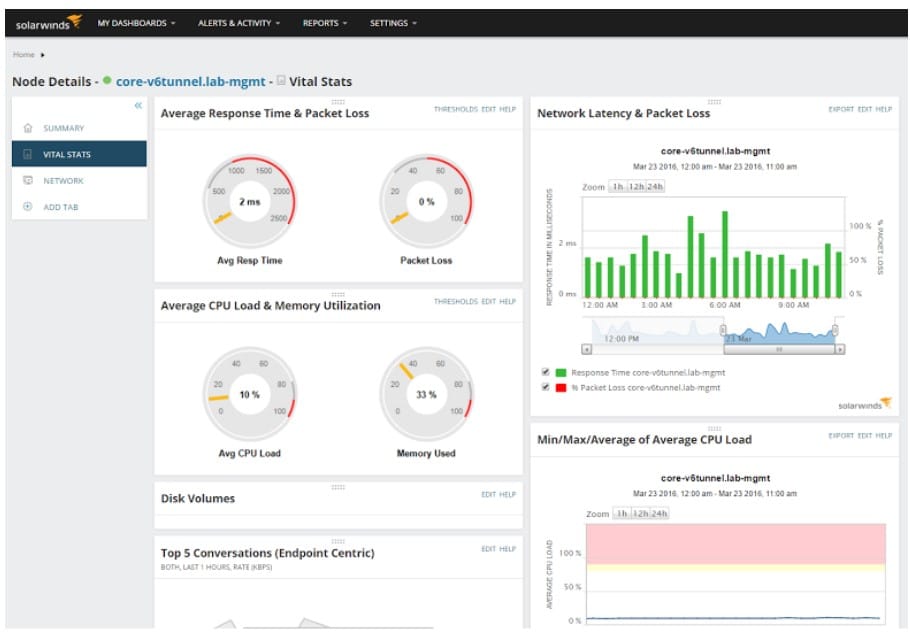
SolarWinds Network Performance Monitor (NPM) is one of the most comprehensive network monitoring and management tools in the market. Its approach to data center monitoring is through a bundle of tools. With this set of products from SolarWinds, you can gain full visibility into the computing, storage, VMs, infrastructure, and applications within your data center.
Key Features:
- Out-of-the-Box Reporting: Provides comprehensive reporting functionalities, offering insights into network performance and health effortlessly.
- Automated Configuration and Change Management: Streamline network configuration tasks and ensure consistency across your infrastructure with automated management features.
- Network Health and Performance Monitoring: Gain real-time visibility into network performance metrics, allowing proactive identification and resolution of issues.
- Physical and Virtual Infrastructure Management: Supports both physical and virtual environments, enabling holistic management of diverse infrastructures.
- Manage Data Center Environmental Monitoring: Monitor environmental factors affecting your data center's performance and stability, ensuring optimal conditions for operations.
Why do we recommend it?
SolarWinds Network Performance Monitor (NPM) stands out as a comprehensive solution for network monitoring and management. Having extensively tested these tools ourselves, we confidently recommend SolarWinds NPM for its robust capabilities in providing full visibility into data center infrastructure. Its intuitive interface coupled with advanced features ensures efficient monitoring and proactive management of network resources. Additionally, SolarWinds NPM offers scalability, making it suitable for businesses of all sizes. With its user-friendly design and reliable performance, SolarWinds NPM emerges as a top choice for IT professionals seeking an all-encompassing network monitoring solution.
How SolarWinds can help you manage your data center:
- Network Performance Monitor for network monitoring,
- Network Configuration Management for automatic network configuration management and backups,
- Virtual Manager for VM monitoring and performance optimization.
- Storage Resource Monitor for storage management and performance monitoring.
With SolarWinds, you can get end-to-end management and monitoring for your entire data center, from a single console. You can get all those SolarWinds tools, integrated into a central and single platform, and get a unified overview of all your components in the data center.
Who is it recommended for?
SolarWinds NPM is ideal for system administrators and IT professionals seeking a centralized solution for managing their data centers. It suits businesses of various sizes, offering scalability and flexibility. Whether you're overseeing a small network or a complex infrastructure, SolarWinds NPM caters to diverse needs with its range of features. Its modular approach allows customization to fit specific requirements, making it suitable for organizations across different industries. From enterprises to small businesses, SolarWinds NPM provides the tools necessary to ensure optimal network performance and reliability.
Pros:
- Auto-Discovery: Builds network topology maps and inventory lists in real-time, facilitating efficient network management.
- Effective Alerting: Boasts some of the best alerting features, striking a balance between effectiveness and user-friendliness.
- Monitoring Flexibility: Supports both SNMP monitoring and packet analysis, providing granular control over monitoring processes.
- Customizable Dashboard: Utilizes drag-and-drop widgets for dashboard customization, enabling users to tailor the interface to their preferences.
- Abundant Templates and Reports: Offers a wealth of preconfigured templates, reports, and dashboard views, enhancing user convenience and productivity.
Cons:
- Feature Overload: While feature-rich, SolarWinds NPM may be overwhelming for non-technical users, particularly those unfamiliar with enterprise-level tools.
Start with a 30-day free trial.
7. Device42
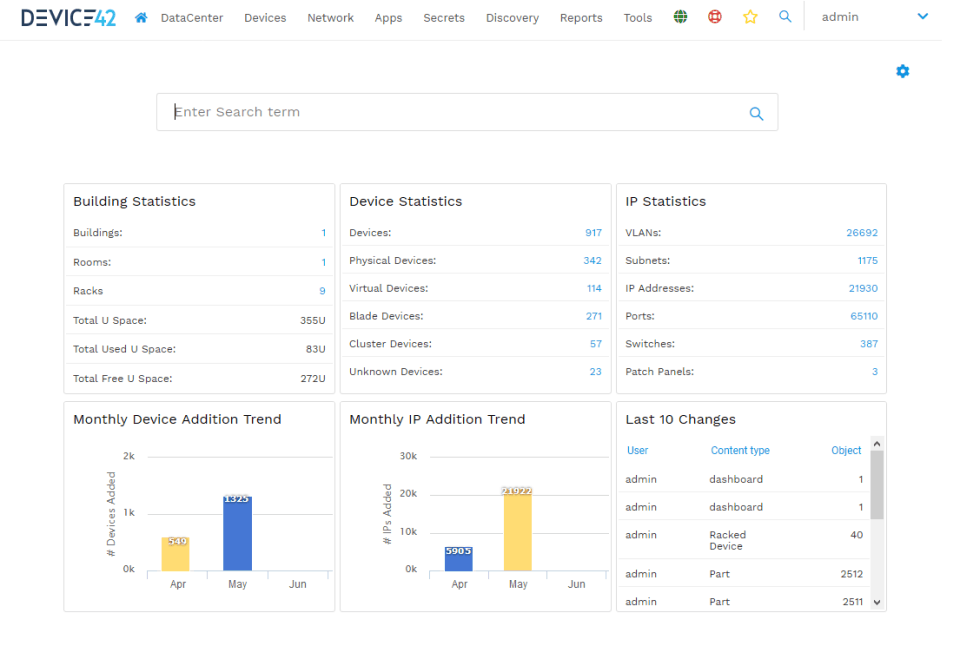
Device42 is a comprehensive DCIM and network management solution. It comes with powerful data center visualization tools that produce smart data center diagrams and layouts.
With its CMDB (Configuration Management Database) feature, Device42 can also provide an overview of all your configuration items so that you can easily manage them.
Key Features:
- Insights into the Computing Environment: Gain comprehensive insights into the computing environment, facilitating efficient management and optimization.
- Application Dependency Mapping: Map dependencies between applications and infrastructure components to understand their relationships and impact.
- Software License Management: Track and manage software licenses to ensure compliance and cost optimization.
- Agentless and Continuous Device Discovery: Automatically discover and inventory devices in the data center, enabling accurate asset management and tracking.
- Power and Environment Management: Monitor and manage power consumption and environmental factors to maintain optimal conditions for equipment.
- Data Center Room and Cabling: Visualize data center room layouts and cabling configurations for enhanced spatial awareness and management.
Why do we recommend it?
Device42 emerges as a leading comprehensive Data Center Infrastructure Management (DCIM) and network management solution, offering powerful features and intuitive tools for efficient data center management. With its robust Configuration Management Database (CMDB) feature, Device42 enables organizations to gain a comprehensive overview of all configuration items, streamlining management processes. The tool's powerful data center visualization tools, coupled with its IT asset management capabilities, make it a preferred choice for businesses seeking to optimize data center operations and enhance efficiency.
The software comes with IT asset management capabilities. The auto-discovery feature finds all nodes in the data center, from on-premises, virtual, or cloud. When the tool finds assets, it includes them in the inventory where you can change their details. Device42 allows native integrations with lots of popular applications used in managing IT Infrastructure.
From tools like JIRA, Slack, Logstash, Zapier, Ansible, Puppet, Chef, and more.
Who is it recommended for?
Device42 is recommended for organizations of all sizes seeking a comprehensive solution for DCIM and network management. Whether you operate a small data center or a large enterprise environment, Device42 caters to diverse needs with its scalable and versatile platform. Specifically, Device42 is ideal for organizations requiring insights into the computing environment, application dependency mapping, and software license management. Its ability to perform agentless and continuous device discovery makes it suitable for managing on-premises, virtual, or cloud-based infrastructure. Device42's native integrations with popular applications further enhance its usability and interoperability, making it a valuable asset for IT professionals across various industries.
Pros:
- Automatic Topology Maps and Dependency Mapping: Produces automatic topology maps and dependency mapping, simplifying visualization and understanding of infrastructure relationships.
- Unique Rack-level Visualization: Offers a unique rack-level visualization to help on-site technicians map physical infrastructure to specific services, enhancing operational efficiency.
- Scalability: Designed to scale in enterprise environments, providing flexibility and reliability to accommodate growing infrastructure needs.
Cons:
- Ease of Creating Custom Affinity Groups: Users may find it challenging to create custom affinity groups, and improvements in this area could enhance customization capabilities.
The license for Device42 is based on an annual subscription. The pricing tiers vary according to the number of managed devices. Device42 Core version has an annual price of $4500 and allows you to manage up to 500 devices and up to 5000 IPs. Get a free trial of Device42
8. Zabbix
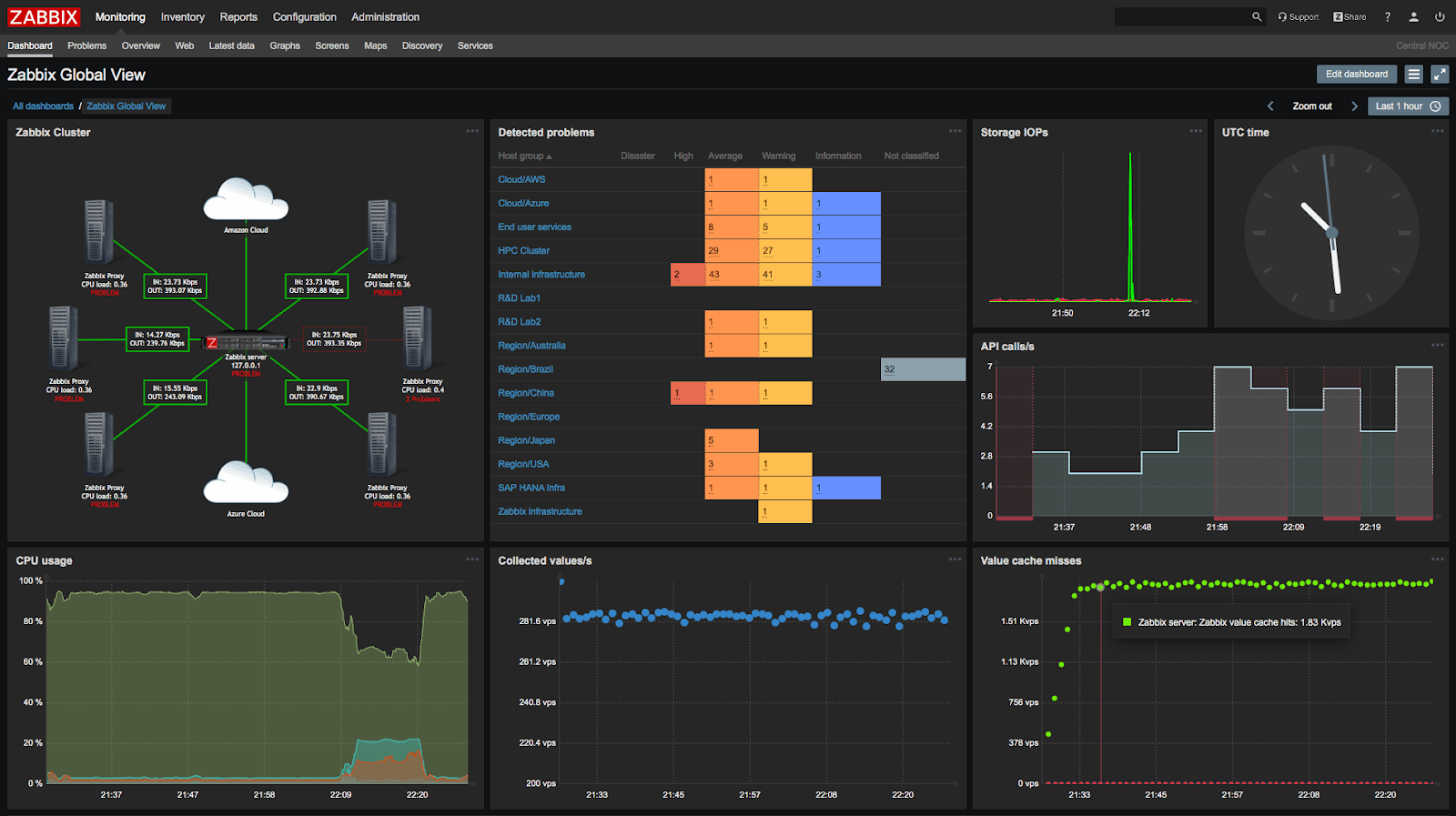
Zabbix is a free and open-source IT Infrastructure management and monitoring software. It helps you control any component of your data center, from servers, network, VMs, databases, storage, applications, and more.
Key Features:
- Distributed Monitoring: Monitor remote data centers or branch offices seamlessly, ensuring comprehensive visibility and control.
- Agentless High-Performance Monitoring: Keep track of different elements in your data center without the need for installing agents, simplifying deployment and management.
- Integrations: Benefit from out-of-the-box integrations with popular vendors such as Cisco, D-Link, Juniper, HP, Netgear, and Huawei, enhancing interoperability and versatility.
Why do we recommend it?
Zabbix stands out as a leading free and open-source IT infrastructure management and monitoring software, offering robust features and scalability for businesses of all sizes. As a transparent and open-source solution, Zabbix provides substantial flexibility and a ton of customization options, empowering organizations to tailor monitoring processes to their specific requirements. With its distributed monitoring capabilities and agentless high-performance monitoring, Zabbix ensures comprehensive visibility and control over data center environments. Zabbix's out-of-the-box integrations with popular vendors further enhance its versatility and interoperability, making it a preferred choice for organizations seeking a reliable and cost-effective monitoring solution.
Zabbix is one of the only open-source products that can scale from small to large environments. Its features allow monitoring up to 100,000 hosts simultaneously. Zabbix shows an overview of the IT environment from a single, visually appealing pane-of-glass. Its native web interface integrates all visuals, from dashboards, graphs, network maps, slideshows, reports, alarms, etc.
Who is it recommended for?
Zabbix is recommended for organizations seeking a flexible and scalable monitoring solution for data center infrastructure. Whether you operate a small business or a large enterprise, Zabbix caters to diverse needs with its versatile platform. Specifically, Zabbix is ideal for organizations requiring distributed monitoring capabilities to monitor remote data centers or branch offices. Its agentless monitoring approach eliminates the need for installing agents on monitored devices, simplifying deployment and management. Zabbix's scalability, supporting monitoring of up to 100,000 hosts simultaneously, makes it suitable for businesses with growing infrastructure needs. From small to large environments, Zabbix provides the tools necessary to ensure optimal performance and reliability across data center environments.
Pros:
- Open-Source Transparency: As an open-source tool, Zabbix provides transparency and flexibility, allowing organizations to customize monitoring processes according to their specific needs.
- Wide Monitoring Range: Utilizes both SNMP and ICMP for a broader monitoring range, ensuring comprehensive visibility into data center infrastructure.
- Immediate Device Detection: Can detect new devices and configuration changes immediately, enabling proactive management and maintenance.
- Useful Templates: Offers a variety of useful templates for quick insights into performance and health metrics, streamlining monitoring processes.
- Robust Notification System: Features a robust notification system supporting SMS, email, custom script, and webhook, ensuring timely alerting and incident response.
Cons:
- Suited for Small to Medium-Sized Businesses: While scalable, Zabbix may be better suited for small to medium-sized businesses, and larger enterprises may require additional customization and configuration for optimal performance.
Zabbix is a free and open-source software. If you want to manage large-scale data centers, Zabbix Enterprise edition might be the best solution. For more information on prices, request a quote. Get the open-source Zabbix and start managing smaller data centers for free!
9. Nagios
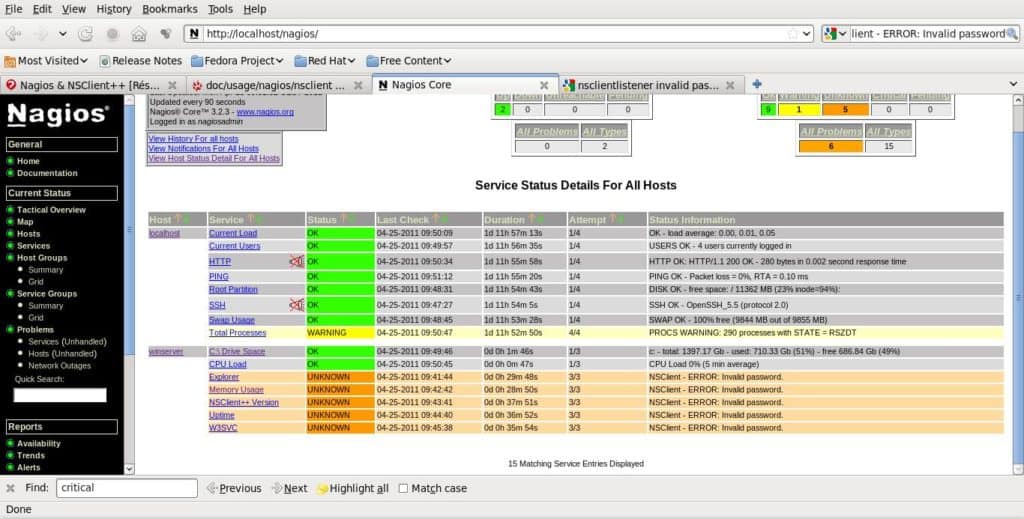
Last but not least is Nagios. This solution has become one of the preferred data center management software for companies looking for an open-source platform. Nagios can monitor many different components in your data center, from routers, switches, servers, storage, data center environment, VMs, etc.
Nagios Core is a free and open-source community-driven monitoring and alerting platform. The engine of Nagios Core serves as a primary application where hundreds of projects are built. The tool comes with nearly 4000 third-party plugins, which are standalone extensions that provide extra intelligence for managing anything within your data center.
Key Features:
- Monitors Single Points of Failure: Identifies and monitors potential single points of failure within data center infrastructure, ensuring reliability and uptime.
- Finds and Monitors SLA Faults: Monitors Service Level Agreement (SLA) faults to ensure compliance and performance optimization.
- Manages Servers and Their Connections: Provides comprehensive server management capabilities, including monitoring server connections and performance metrics.
- Monitors Environmental Factors: Tracks environmental factors such as temperature and humidity to maintain optimal conditions for equipment.
Why do we recommend it?
Nagios has established itself as a leading data center management software, particularly favored by organizations seeking an open-source monitoring solution. As a free and community-driven platform, Nagios Core offers unparalleled transparency and flexibility, empowering organizations to customize monitoring processes according to their specific requirements. With its extensive library of third-party plugins and nearly 4000 plugins available, Nagios provides comprehensive monitoring capabilities for managing various aspects of data center infrastructure. Nagios's focus on monitoring single points of failure and managing SLA faults makes it a preferred choice for businesses prioritizing reliability and uptime.
Out of the box, Nagios Core does not have a dashboard or a Graphical User Interface (GUI). But you can install a GUI from the list of plugins. Nagios XI, which is the commercial version, has extra features like reporting, web interface, diverse monitoring capabilities, and more. Nagios was created for Linux operating systems, but it can also run on Windows using extensions such as Check_MK or Nagwin.
Who is it recommended for?
Nagios is recommended for organizations seeking a flexible and customizable monitoring solution for data center management. Whether you're a small business or a large enterprise, Nagios caters to diverse needs with its versatile platform. Specifically, Nagios is ideal for organizations looking for an open-source solution with extensive monitoring capabilities. Its robust alerting options, including support for SMS and email, make it suitable for organizations requiring timely notifications of critical issues. While the open-source version lacks some features found in commercial products, Nagios Core serves as a solid foundation for organizations looking to build custom monitoring solutions tailored to their unique requirements. From Linux to Windows environments, Nagios offers scalability and adaptability to suit various operating systems and infrastructure setups.
Pros:
- Open-Source Transparency: As an open-source tool, Nagios provides transparency and flexibility, enabling organizations to customize monitoring processes according to their specific needs.
- Simple yet Informative Interface: Offers a simple yet informative interface, providing essential monitoring data and insights at a glance.
- Flexible Alerting Options: Supports flexible alerting options, including SMS and email, ensuring timely notification of critical issues.
- Robust API Backend: Features a robust API backend, making it a great option for developers who want to integrate custom applications and extend functionality.
Cons:
- Quality Support: The open-source version lacks the quality support found in paid products, requiring organizations to rely on community resources for assistance.
- Complex Installation: Installation can be complex compared to competing products, requiring additional configuration and setup steps for deployment.
Nagios Core is free and open-source software. The Nagios Core XI price starts at $1,995 for a single standard license. Get a Nagios Core, or get a 60-days free trial version of Nagios XI.
Summary
Data centers are complex facilities. Some of them have hundreds or thousands of devices interconnected together through networking equipment and endless cabling. But networking is not the only player in a data center; there are servers, firewalls, storage appliances, cooling and power systems, and more.
Some superhero IT managers are capable of keeping these sophisticated environments in place, through spreadsheets and diagramming apps, but the sky has a limit. The DCIM and the broader data center management tools will help you automate processes, improve uptimes, keep things organized, plan for capacity, and more.
There are way too many benefits in these platforms that it is hard to continue using traditional administration solutions. Most of these tools have free versions of their software, and some others have fully-featured free trials for a limited time. So there is no excuse to not start managing your data center today!
Data Center Management Software FAQs
What is data center management system?
A data center can be an in-house department or a managed service. The center provides IT services for other departments in the business or other businesses. Typically, a data center will support multiple sites and only be contactable via email, phone, or ticketing system. The data center needs to manage infrastructure and applications.
What is data center monitoring?
Data center monitoring involves watching over the performance of networks, servers, and applications. These facilities are used by a business and the data center is either an in-house department or a managed service provider’s organization. The data center staff needs to ensure that infrastructure and applications perform sufficiently well that the users of the system can continue to perform their work. This task requires catching problems before they evolve and automated monitoring tools provide this service.
What is data center infrastructure?
Data centers can provide physical equipment for businesses, such as servers. The data center also needs to connect those servers to the users and this involves both a local network and internet connections. These utilities together form the infrastructure of the data center.
